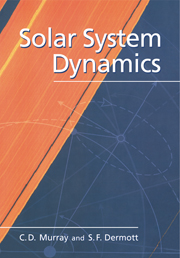Book contents
- Frontmatter
- Contents
- Preface
- 1 Structure of the Solar System
- 2 The Two-Body Problem
- 3 The Restricted Three-Body Problem
- 4 Tides, Rotation, and Shape
- 5 Spin–Orbit Coupling
- 6 The Disturbing Function
- 7 Secular Perturbations
- 8 Resonant Perturbations
- 9 Chaos and Long-Term Evolution
- 10 Planetary Rings
- Appendix A Solar System Data
- Appendix B Expansion of the Disturbing Function
- References
- Index
5 - Spin–Orbit Coupling
Published online by Cambridge University Press: 05 June 2012
- Frontmatter
- Contents
- Preface
- 1 Structure of the Solar System
- 2 The Two-Body Problem
- 3 The Restricted Three-Body Problem
- 4 Tides, Rotation, and Shape
- 5 Spin–Orbit Coupling
- 6 The Disturbing Function
- 7 Secular Perturbations
- 8 Resonant Perturbations
- 9 Chaos and Long-Term Evolution
- 10 Planetary Rings
- Appendix A Solar System Data
- Appendix B Expansion of the Disturbing Function
- References
- Index
Summary
This common body,
Like to a vagabond flag upon the stream,
Goes to and back, lackeying the varying tide,
To rot itself with motion.
William Shakespeare, Anthony and Cleopatra, I, ivIntroduction
In the last chapter,we considered the effect of tides raised on a satellite by a planet where we assumed that the satellite was in a synchronous spin state (i.e., that the rotational period of the satellite was equal to its orbital period). As mentioned in Sect. 1.6, most of the major natural satellites in the solar system are observed to be rotating in the synchronous state. How did this situation arise and what determines the spin–orbit state of a given satellite or planet? In this chapter, we start by further examining the effects of a tidal torque on a satellite's rotation. This analysis reveals why, for example, in order to maintain its synchronous spin–orbit resonance, the Moon must have a permanent quadrupole moment. The consequences of this extra torque on the system are then examined and this leads to a general approach to the concept of spin–orbit resonance in the solar system. The origin and stability of these resonances are also discussed.
Tidal Despinning
Consider the case of a satellite orbiting a planet in an elliptical orbit. Those parts of the orbit in which the satellite's spin rate, which we denote by + n, is less (or greater) than its angular velocity or the rate of change of its true anomaly, are shown in Fig. 5.1a.
- Type
- Chapter
- Information
- Solar System Dynamics , pp. 189 - 224Publisher: Cambridge University PressPrint publication year: 2000

